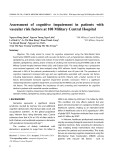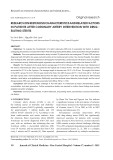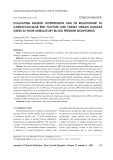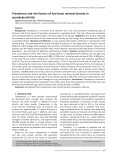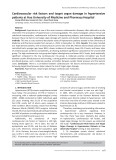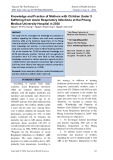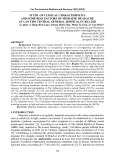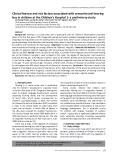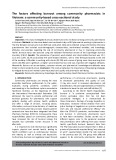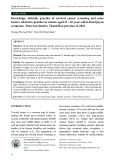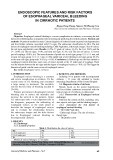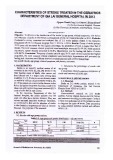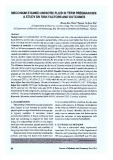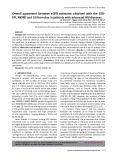
HUE JOURNAL OF MEDICINE AND PHARMACY ISSN 3030-4318; eISSN: 3030-4326 103
Hue Journal of Medicine and Pharmacy, Volume 14, No.6/2024
The factors affecting burnout among community pharmacists in
Vietnam: a community-based cross-sectional study
Le Tran Tuan Anh1, Ngo Thi Kim Cuc2*, Vo Thi Tan Tien2 , Nguyen Phuoc Bich Ngoc2,
Nguyen Thi Phuong Thao3, Tran Nhu Minh Hang1, Le Chuyen4
(1) Department of Psychiatry, Hue University of Medicine and Pharmacy, Hue University
(2) Faculty of Pharmacy, Hue University of Medicine and Pharmacy, Hue University
(3) Institute for Community Health Research, Hue University of Medicine and Pharmacy, Hue University
(4) Pharmacology Department, Hue University of Medicine and Pharmacy, Hue University
Abstract
Objectives: This study investigated burnout prevalence and its risk factors among community pharmacists
in Vietnam. Methods: An interview-based cross-sectional study on 362 pharmacists working in pharmacies in
Hue City between January and June 2023 was conducted. Data were collected using a Vietnamese interview
questionnaire that included socio-demographic characteristics, work-related variables, and knowledge,
attitudes, and practices regarding the role of community pharmacists in Hue in improving community
health. Burnout status was assessed using the validated Vietnamese version of the Copenhagen Burnout
Inventory (CBI-V). Results: The prevalence of personal, work-related, and client-related burnout was 12.7,
12.4 and 11.6%. 53.3% occasionally felt work-related tiredness, with a third feeling exhausted at the end
of the workday. Difficulties in working with clients (39.2%) and a sense of giving more than receiving from
clients (34.8%) were significant. A higher work-related burnout rate was reported with negative attitudes.
Meanwhile, factors such as workplace, customer volume, and pharmacists’ knowledge and attitudes were
linked to client-related burnout. Conclusion: This study emphasizes the importance of developing strategies
to mitigate burnout and maintain pharmaceutical care quality and pharmacist well-being.
Keywords: Community pharmacy, Copenhagen Burnout Inventory, Good Pharmacy Practices, Healthcare.
Corresponding Author: Ngo Thi Kim Cuc, email: ntkcuc@huemed-univ.edu.vn
Received: 17/6/2024; Accepted: 24/11/2024; Published: 25/12/2024
DOI: 10.34071/jmp.2024.6.15
1. INTRODUCTION
Community pharmacists are among the most
accessible healthcare professionals to the public,
especially during pandemic conditions, when
overcrowding in the healthcare system overwhelms
healthcare facilities. At the beginning of 2020,
the International Pharmaceutical Federation (FIP)
addressed the need to provide professional and
technical guidance for pharmacists who support
patients dealing with primary health problems
and offer a range of services, including advice,
information, and even home delivery of medicines
[1]. Community pharmacy services towards patient-
centered care have also been integrated into Good
Pharmacy Practices (GPP) [1]. Consequently, these
responsibilities placed on community pharmacists
have increased the risk of burnout among this
valuable but vulnerable human resource in the
aftermath.
It is important to note that burnout significantly
impacts physical and mental health, leading to
health conditions such as cardiovascular diseases
and obesity, as well as anxiety and depression.
Furthermore, burnout can negatively impact the job
performance of community pharmacists, leading
to decreased productivity and quality of care.
It may also result in increased absenteeism, job
dissatisfaction, reduced organizational commitment,
intentions to leave the job, and staff attrition [2].
According to the World Health Organization,
burnout is “a syndrome conceptualized from
chronic workplace stress that has not been
successfully managed. It is characterized by
three dimensions: feelings of energy depletion or
exhaustion, increased mental distance from one’s
job or feelings of negativism or cynicism related to
one’s job, and reduced professional efficacy” [3].
After the COVID-19 pandemic, work-related stress
and burnout in community pharmacists seem
to have been overlooked. Studies carried out in
different regions prior to the pandemic revealed
that pharmacists were suffering from poor mental
health, specifically burnout. Research data from
The Pharmaceutical Journal showed that in 2021, a
quarter of pharmacists reported being “very stressed
at work”, approximately double the rate reported
in the previous year [4]. The group most affected
appears to be community pharmacists. Based on





